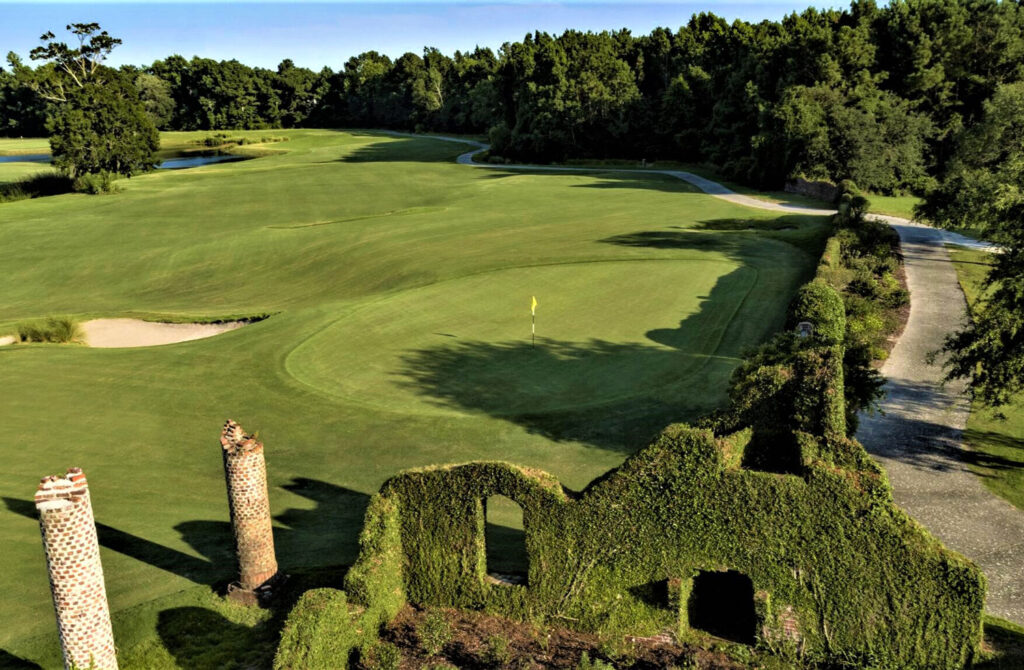For golf course superintendents seeking inspiration, insight, and best practices, Barefoot Resort & Golf in North Myrtle Beach, South Carolina, is an exemplary destination. Home to four world-renowned courses – the Dye Course, Love Course, Fazio Course, and Norman Course – Barefoot Resort showcases design brilliance from some of the most iconic names in golf course architecture. Each course has distinct characteristics that test golfers while posing unique challenges and opportunities for superintendents to maintain these layouts to the highest standards.
The Courses at Barefoot Resort & Golf

1. The Dye Course
- Architect: Pete Dye
- Course Style: Links-style with challenging bunkering and risk-reward opportunities
- Key Holes to Note:
- Hole 9: A stunning par-3 that incorporates Dye’s hallmark visual intimidation with strategically placed bunkers.
- Hole 18: A picturesque closing par-4 featuring an elevated green and water hazards that demand precision.
- Superintendent’s Challenge: The Dye Course requires meticulous attention to its expansive waste bunkers and undulating greens. The Bermuda grass must be kept at peak playability year-round while managing Dye’s notorious use of rugged native areas to frame fairways.

2. The Love Course
- Architect: Davis Love III
- Course Style: Traditional Carolina layout with historical ruins integrated into the design
- Key Holes to Note:
- Hole 4: A par-5 with the remnants of old plantation ruins, providing both aesthetic beauty and unique maintenance considerations.
- Hole 18: A challenging par-4 with strategic mounding and a large green complex that tests golfers of all levels.
- Superintendent’s Challenge: Maintaining the pristine conditioning of fairways and greens while preserving the historical features woven into the design requires a thoughtful approach to aeration, irrigation, and turf health.

3. The Fazio Course
- Architect: Tom Fazio
- Course Style: Parkland-style design featuring tree-lined fairways and water hazards
- Key Holes to Note:
- Hole 7: A par-4 where golfers contend with water along the left side and a sloping green.
- Hole 15: A long par-3 with a large bunker complex guarding the green.
- Superintendent’s Challenge: The Fazio Course’s lush landscaping and extensive use of water features require precise irrigation management. The Champion Bermuda greens demand close monitoring for firmness and speed consistency.

4. The Norman Course
- Architect: Greg Norman
- Course Style: A natural layout with minimal earthmoving, designed to blend seamlessly with the surrounding environment
- Key Holes to Note:
- Hole 10: A risk-reward par-4 that invites golfers to challenge water on the right side for a shorter approach.
- Hole 17: A dramatic par-3 with water surrounding three sides of the green.
- Superintendent’s Challenge: Maintaining the minimalist design requires balancing native areas with finely groomed turf. Transitioning between natural rough and playable turfgrass is key to honoring Norman’s vision.
Maintenance Insights and Practices
Maintaining four championship-level courses at Barefoot Resort is no small feat. Here are key aspects of their maintenance program that superintendents can learn from:
1. Turfgrass Management
Barefoot Resort primarily features Bermuda grass varieties, including Champion Bermuda on greens and hybrid Bermuda on fairways. The team prioritizes:
- Seasonal Aerification: Regular deep-tine aeration ensures proper root growth and alleviates compaction.
- Topdressing: Light and frequent topdressing maintains green smoothness and firmness.
- Irrigation Management: Advanced irrigation systems allow for precision water control to avoid over-saturation while maintaining uniform turf health.
2. Bunker Maintenance
Each course’s design incorporates extensive bunkering, from Pete Dye’s rugged waste areas to the clean, traditional edges on the Love Course. Key practices include:
- Daily Raking: Mechanical and hand-raking to ensure consistent playability.
- Sand Depth Management: Frequent checks to avoid washouts during heavy rain events.
- Edge Definition: Maintaining clean lines enhances aesthetics while preventing encroachment.
3. Native Areas and Rough Management
The Norman and Dye Courses, in particular, make extensive use of native grasses and natural areas. Superintendents focus on:

- Selective Mowing: Maintaining specific mowing heights to strike a balance between visual appeal and playability.
- Weed Control: Integrated pest management (IPM) practices keep invasive species in check.
- Environmental Sustainability: Preserving native habitats for wildlife aligns with Barefoot’s commitment to eco-friendly maintenance.
4. Water Management
With water hazards playing a prominent role across all four courses, maintenance teams employ advanced drainage systems and water circulation techniques to:
- Prevent algae buildup and stagnation
- Protect surrounding turf from over-watering
- Maintain aesthetic clarity in ponds and streams
Lessons for Superintendents
Barefoot Resort & Golf serves as a case study for golf course superintendents striving for excellence. From the diversity in course designs to the precision required for maintaining championship-level turf, the resort exemplifies how creativity and consistent maintenance practices can produce exceptional playing conditions.
Superintendents looking to implement similar practices at their courses can take away valuable lessons in:
- Balancing aesthetics with playability
- Implementing sustainable maintenance techniques
- Managing unique architectural challenges while preserving design integrity
Final Thoughts
Barefoot Resort & Golf serves as a valuable source of ideas and inspiration for superintendents. Its four courses – the Dye, Love, Norman, and Fazio designs – present unique maintenance challenges and creative opportunities. Each course demonstrates the art of balancing aesthetics, playability, and sustainability.
A visit to Barefoot Resort provides a firsthand look at how to maintain exceptional conditions on high-profile courses. Superintendents can learn techniques and strategies to enhance their own courses, contributing to the preservation and improvement of golf’s treasured landscapes.



























